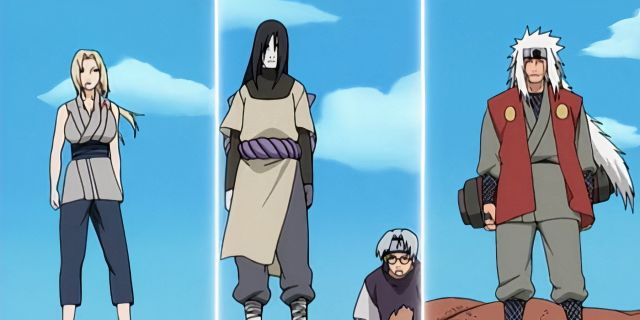Highlights
- The Three-Way Deadlock concept originates from the legendary Sannin trio in Naruto, symbolizing a stalemate between three parties of equal power.
- Inspired by Japanese hand games like Mushi-ken, the Sannin’s animal summons represent the snake, frog, and slug, each vulnerable to one while stronger than the other.
- The new generation of Team 7 inherits the concept and summons, but their power disparity differs from the original Sannin deadlock.
The Legendary Sannin’s influence on Naruto’s narrative spreads far and wide, whether it’s taking in each member of Team 7 under their tutelage or lending support to the Hidden Leaf from the backdrop. The Three-Way Deadlock is another concept that originates from this legendary trio, one that refers to an impasse between the three Sannin and their respective animal summons.
On the surface, the Three-Way Deadlock presents a mere stalemate between three belligerents of equal power, yet this concept holds a deeper, symbolic meaning. This very notion has even trickled down to the new generation after Team 7 adopted their masters’ respective summons, keeping the Naruto series’ iconic stand-off running.
What Is the Three-Way Deadlock?
The Three-Way Deadlock was first witnessed during the Search For Tsunade arc where Jiraiya, Orochimaru, and Tsunade faced off against each other in a heated battle. While Jiraiya and Tsunade, coupled with Katsuyu and Gamabunta, two-manned Orochimaru and Manda, the result was still an impasse between the three Sannin, alluding to near-equal strength on both sides.
Make one move… and I’ll kill you – Tsunade
Another instance of the Three-Way Deadlock between the Sannin took place during the Second Great Ninja War, with Orochimaru threatening to kill off an injured Jiraiya to shed off some dead weight. However, Tsunade’s intervention barred Orochimaru from continuing, as she threatened to kill him if he dared to lay a finger on Jiraiya. In this situation, each party would lose from taking action, resulting in a classic three-way deadlock.
The concept is akin to a Mexican Standoff, where three parties have no other choice but to call a truce. However, Naruto’s Three-Way Deadlock originates from an entirely different source, one rooted in Japanese hand games that date all the way back to the 17th and 18th centuries.
The Symbolism of the Sannin’s Deadlock

While a Three-Way Deadlock is a common phenomenon used in three-party battles, Naruto adds a symbolic touch to this classic concept. The Sannin’s three summons are based on Japanese Sansukumi-ken games, a type of hand-game that involves three different hand gestures, each representing an animal. Naruto makes use of Mushi-ken, a game that has three hand signs representing a snake, a frog, and a slug.
The snake will eat the frog, but the slug will dissolve the snake with its poison. However, the slug itself can be eaten by the frog, turning this into a stalemate where each party is vulnerable to one, while stronger than the other. The game of Rock Paper Scissors also originates from the traditional Japanese game of Mushi-ken, replacing the concept of animals with inanimate objects.
How Do the Sannin Represent Sansukumi-ken?

The three Sannin embody each animal of Mushi-ken, as Jiraiya, Tsunade, and Orochimaru reflect the frog, slug, and snake respectively. In this case of the Three-Way Deadlock, the frog (Jiraiya) is vulnerable to the snake (Orochimaru), but the snake is unable to act as the slug (Tsunade) will dissolve it. While slugs aren’t exactly known to kill snakes, the Japanese version of the story presents slugs as capable of dissolving snakes with their mucus.
In simple terms, the concept is more akin to Rock Paper Scissors, where rock beats scissors, paper beats rock, and scissors beats paper. Sansukumi-ken roughly translates to “three who are afraid of each other,” which perfectly summarizes the Three-Way Deadlock. If one party strikes the other, the third will strike down the first aggressor, albeit only if all three belligerents are equal in power. In the case of the Sannin, all three members boast equal power, perfectly emulating the game of Mushi-ken.
The New Three-Way Deadlock
The Sannin aren’t the only ones to reflect the concept of the Three-Way Deadlock, as their proteges take up the mantle after inheriting their respective animal summons. Naruto, Sasuke, and Sakura’s reunion on the battleground of the Fourth Great Ninja War is immediately followed by the three summoning their animal familiars, prompting Orochimaru to comment on the new generation deadlock.
Around now, a new Three-Way Deadlock is probably making its debut.
While Sasuke, Naruto, and Sakura have never been in a situation that called for a three-way deadlock, inheriting the teachings and powers of their masters deems them the successors of the original trio. Moreover, their summons also reflect the Japanese Sansukumi-ken, with the three forming contracts with frogs, snakes, and slugs. Even Hiruzen states that the sight of their summons reminded him of the Sannin in their youth.
While Team 7 might represent the symbolic sentiments of the Three-Way Deadlock, their outcome would surely vary from their predecessors. The Sannin were of equal power and prestige, yet Team 7 bears a clear power disparity, largely with Sakura being the weakest link. However, Team 7’s new Three-Way Deadlock is merely a nod to the original deadlock, along with the Japanese Sansukumi-ken that inspired the concept in the first place.
Naruto is available to stream on Prime Video.











Leave a Reply